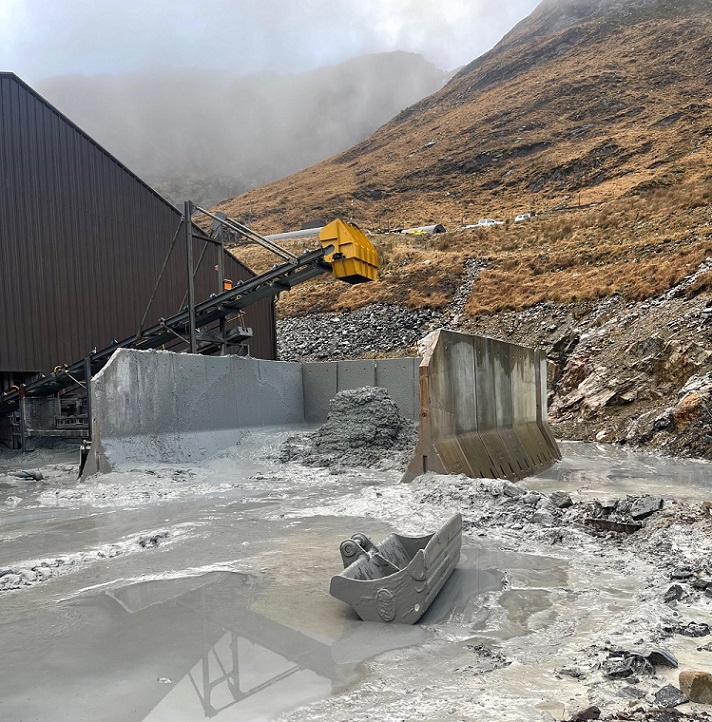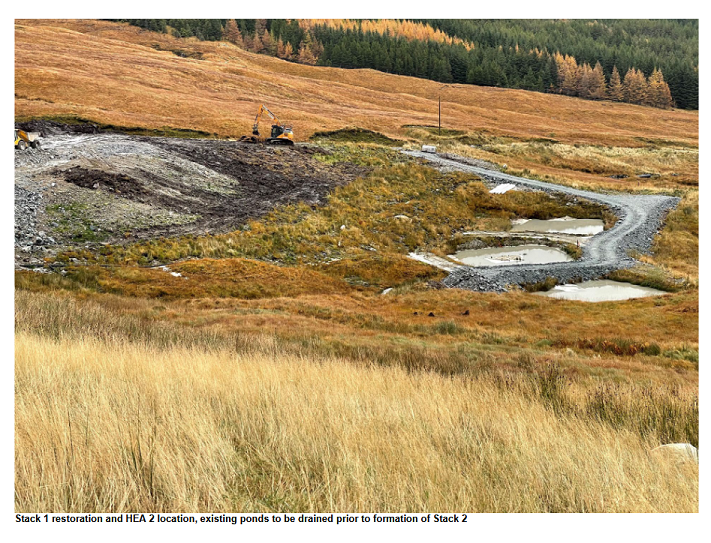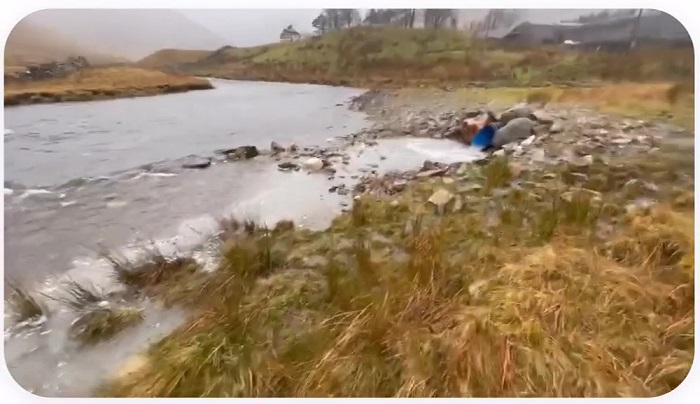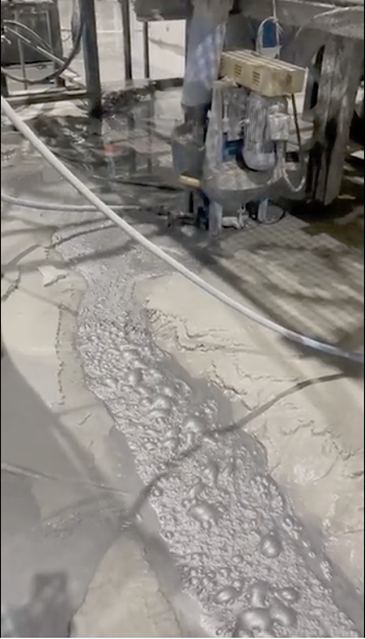
My post on the financial crisis at the Cononish goldmine last week (see here) prompted some very interesting comments and a number of photos which have been published on twitter (see here for photos, videos and commentary). These suggest that environmental conditions are, as I feared, being breached.
Tailing disposal
Under the approved waste management plan for the mine tailings were supposed to be “de-watered” and have less than 20% water content. The annual report to the Loch Lomond and Trossachs National Park Authority (LLTNPA)’s planning committee reported last December that “Scotgold have installed a tailings “thickener” within the processing plant which reduces the water content of the tailings”. The photo above suggests that is not happening and the tailings are far wetter than they should be.

The tailings are moved from the bunker to the stacks, the large heaps designed to look like moraines, the first of which was reported to be nearing completion in December. The stacks replaced the original proposal for a large tailings dam and were supposed to be better for the environment and easier to engineer. That, however, depended on their being “dry”.
In November 2019 the LLTNPA approved a Non-Material Variation to the original planning consent allowing the settlement ponds, which were designed to allow the sedimentation of particles in the run-off from the stacks and the plant processing area (as in the top photo, to be increased in size from 810m3 to 3900m. That huge increase was justified by the need to cater for 1 in 10 year storm events but was also supposedly enough to manage leakages from all ten stacks once constructed.

The evidence from this video clip suggests that when it is wet the settlement ponds are completely insufficient to contain the sediment and overflow. The result is sediment is being carried into the Cononish and the river system below, a Special Area of Conservation and supposedly one of Scotland’s most highly protected river systems.
If the tailings are wetter than they are supposed to be that just adds to the problems caused by the very high rainfall in the area. It also increases the likelihood of the stacks collapsing/suffering catastrophic slides.
One wonders whether the LLTNPA, Scottish Environmental Protection Agency (SEPA) or NatureScot ever visit the mine in wet weather to see what is going on?
Inside the plant

The plant separates the minerals from the rock waste through crushers and the use of chemicals to form the concentrate from which the gold is later extracted. That is not being done as stringently as it should be, as this photo shows, with concentrate flowing onto the plant floor and then leaking out of the building. The concentrate contains minerals like sulphides – formed from crushed pyrites from the rocks – which pollute the tailings and help create Acid Mine Drainage (AMD), something which the mine was supposed to avoid.
I have alerted SEPA to this and it will be interesting to see how they respond.
A National Park Authority out of their depth?
My last post revealed how, after agreeing to increase the amount of the restoration bond for the mine – if the tailings are polluted with AMD that could cost a fortune to clear up – the LLTNPA had refused to disclose what was happening as they were in correspondence with the operator, SGZ Cononish Ltd. I have subsequently found out there is no need for this because under the Section 75 Agreement which governs the operation of the mine:

The LLTNPA therefore could have forced Scotgold to increase the restoration bond within 28 days but instead have chosen to negotiate for four months. Given the precarious finances of the SGZ Cononish Ltd that looks foolhardy.
How likely is it that the Cononish Mine will go bust?
There have been significant drops in gold grades at the Cononish Mine over the past 6 months and a comment on my last post suggests that the most recently announced 4.9g/t April grade from the new long haul stope, which was contained in around 1200 tonnes of ore, won’t keep the company afloat for long.
That commentator, who appears to have very well informed, has also stated:
“Scotgold also appear to be in imminent danger of being investigated by both the Financial Conduct Authority and AIM Markets for possible market abuse during recent fundraisings”
AND
“Ofcom is now investigating the BBC for broadcasting fake news about a new gold vein discovery at Cononish, fed to its reporter by Scotgold CEO, Phil Day during a BBC Scotland facility visit. Scotgold had not made any market announcement about a new gold vein discovery but the BBC didn’t bother to check. This was shortly before Scotgold launched a £3m equity fundraising so it looks very much like market manipulation and abuse.”
This raises the question whether, had the LLTNPA published its monitoring reports in real time and not six months afterwards, this might have influenced the response from the public to the share offers? That all depends on the content of those reports but had the Monitoring Officer and the LLTNPA picked up on the pollution problems which are now apparently afflicting the mine, it might have told investors that the financial position at Cononish was far more serious than Scotgold was suggesting. With the continued absence of SGZ Cononish accounts for the year to June 2022 it seems to me even more important that the LLTNPA is transparent about what is happening at the mine.
Given all of this, it appears SGZ Cononish is unlikely to raise significant new funds through further share offers and could be about to go bust. Its main shareholder, however, Nathaniel Le Roux has taken public companies back into private ownership before. Scotgold appears to have listed itself on the Alternative Investment Market – at a cost of maybe £250k a year (see here) – after the banks declined to lend more money. Having subsequently financed the development of the mine through various share offers and with those shares having dropped in value to around 16p, it would not cost that much for Mr Le Roux to offer to buy out other shareholders.
Whether he or someone else does probably depends on how much gold they believe is at the end of those tunnels. For the 100 or so people working at the mine this is not an easy time but that is no excuse for any relaxation in environmental standards or adding to what looks like it could be a very large public clear up bill.
In that respect it is worth noting that the Crown Estate, which has benefited from rents for the mine and is party to the Section 75 Agreement, is explicitly excluded from having to contribute to the clear up costs should the mine go bust and the restoration bond be insufficient. Those acting for King Charles, who has received a quarter of the monies for the mine, certainly know how to protect the Royal Family from any liability!

The frequently touted tailings thickener (“delivered”, “erected”, “installed”, “ready to go”) is something of a Greek tragedy. A source at the mine tells me that it isn’t operational, never has been operational and is unlikely to be operational since it doesn’t have the necessary pumps and piping connected and there is no money to pay for their purchase or installation.
Yes, Nick, this is another example of LLTNPA being out of its depth. I appreciate that not everyone in a National Park authority board can have the competence to manage such relatively complex issues, but it looks like their professional advice (assuming they took some) has been very much lacking.
To state the obvious, such agreements, especially with a company of dubious standing, need to assume the worst case scenario in the wording of the agreements. It’s clear to me that LLTNPA were beguiled by the prospect of a headline grabbing development and the creation of jobs, and forgot that if everything goes ‘pear shaped’ – which was always more than likely in a high risk venture like this – someone has to clean up the mess….and that should not be the public purse. I suspect that the LLTNPA is being ‘blackmailed’ by Scotgold and its owners by saying if you press us too hard on the environmental controls and the increase in the Bond, we will just liquidate the company.
It is about time that the persons who are Directors in public authorities such as LLTNPA and SEPA are held financially accountable for mistakes in such agreements and/or in the enforcement of these agreements. Additionally, who allowed the Crown Office to exempt itself from environmental liabilities if Scotgold when into liquidation with significant clean up required to protect the environment?
What a mire of negligence and incompetence!
hi nick ,
as you know ive been very interested on whats going on at cononish
for quite a while now,and im sure you remember me even contacting the rspb
(might sound a bit left field but golden eagles are protected so i thought)
ive been on my soapbox at every opportunity trying to get people to understand
the enviromental disaster that WILL happen ,just look at those minerals that are
found with gold, those minerals were used to kill people in the 2 world wars arsenic
there is another that nations threaten the world with uranium
although safe in the ground when they oxidize(not so safe)
the so-called mine is run on the cheap and always has been
clandestine meetings about expansion(they have been test drilling eveywhere)
mr owen mckee once a board member of the LLTNPA held shares in scotgold
the good folk of tyndrum were conned and sold a fairytale
if anyone one has been to wanlockhead go to the villlage and turn left
its an absolute wasteland they thought the motherlode was there too
(they were wrong)
look at other places in the world the animas river incident for instance
the R.CONONISH runs into other rivers too and if im not mistaken
ends up in LOCH TAY
went recently and got a picure of me standing where i should be waist deep in water
didnt even get my feet wet
what chemicals are they using?god knows
what type of lethal concoction are they creating,between the stuff they are mining out
and the chemicals they are using to extract the gold,gold has a price
and its mainly on the enviroment and the people who live there
The clearest lesson should be that there was not enough accurate information included in the planning application to allow a proper assessment of the proposal. As soon as the developer comes back in need of ammendments, variations and extensions alarm bells should sound very loudly.
A planning authority with no experience of managing such developments, under “jobs” pressure and political pressure stoked through lobbying are bound to loose control. Scottish Government knows this and encourage arrangements for planning authorities to share expertise. Top tips….monitor adherence to plans and conditions and MAINTAIN THE BOND.